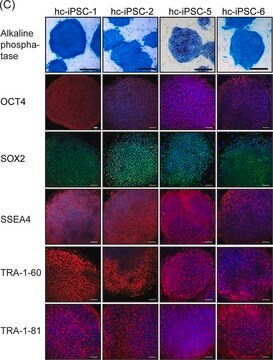おすすめの製品
由来生物
mouse
品質水準
結合体
ALEXA FLUOR™ 488
抗体製品の状態
purified immunoglobulin
抗体製品タイプ
primary antibodies
クローン
7F7.1, monoclonal
化学種の反応性
human
テクニック
immunocytochemistry: suitable
アイソタイプ
IgG2a
NCBIアクセッション番号
UniProtアクセッション番号
輸送温度
wet ice
ターゲットの翻訳後修飾
unmodified
遺伝子情報
human ... NANOG(79923)
詳細
NANOG (Homeobox protein NANOG) is a member of the Nanog homeobox family of DNA-binding proteins. It is expressed in embryonic stem cells and confers pluripotency on these cells. Once embryonic stem cells become differentiated, NANOG expression is suppressed. NANOG is involved in the Hedgehog/Gli1 signaling pathway which has been implicated in the development and growth of various types of tumors. NANOG has also been identified as a key transcription factor used to generate induced pluripotent stem cells.
アプリケーション
Anti-NANOG Antibody, clone 7F7.1, Alexa Fluor 488 conjugate.
品質
Evaluated by Immunocytochemistry in H9 human embryonic stem cells. Immunocytochemsitry Analysis: A 1:100 dilution of this antibody detected NANOG in H9 human embryonic stem cells.
ターゲットの説明
The uncojugated parent antibody (Catalog No. MABD24) has an observed MW of 39 kDa
物理的形状
Purified mouse monoclonal IgG2a conjugated to Alexa Fluor™ 488 in PBS with 0.1% sodium azide and 15mg/ml BSA.
その他情報
Concentration: Please refer to the Certificate of Analysis for the lot-specific concentration.
法的情報
ALEXA FLUOR is a trademark of Life Technologies
適切な製品が見つかりませんか。
製品選択ツール.をお試しください
保管分類コード
12 - Non Combustible Liquids
WGK
WGK 2
引火点(°F)
Not applicable
引火点(℃)
Not applicable
適用法令
試験研究用途を考慮した関連法令を主に挙げております。化学物質以外については、一部の情報のみ提供しています。 製品を安全かつ合法的に使用することは、使用者の義務です。最新情報により修正される場合があります。WEBの反映には時間を要することがあるため、適宜SDSをご参照ください。
Jan Code
MABD24A4:
試験成績書(COA)
製品のロット番号・バッチ番号を入力して、試験成績書(COA) を検索できます。ロット番号・バッチ番号は、製品ラベルに「Lot」または「Batch」に続いて記載されています。
Breanna S Borys et al.
Stem cell research & therapy, 12(1), 55-55 (2021-01-14)
Human induced pluripotent stem cells (hiPSCs) hold enormous promise in accelerating breakthroughs in understanding human development, drug screening, disease modeling, and cell and gene therapies. Their potential, however, has been bottlenecked in a mostly laboratory setting due to bioprocess challenges
Quan Qi et al.
International journal of molecular medicine, 35(3), 569-578 (2014-12-20)
The present study aimed to investigate the X chromosome inactivation (XCI) status in long-term cultured human parthenogenetic embryonic stem cells. One human embryonic stem (hES) cell line and 2 human parthenogenetic embryonic stem (hPES) cell lines were subjected to long-term
Melissa Conti Mazza et al.
Stem cell research, 55, 102506-102506 (2021-08-23)
Mutations in the oncogene PARK7, which codes for DJ-1, have been associated with early-onset autosomal recessive Parkinson's disease (PD); however, the exact role of DJ-1 in PD remains elusive. Fibroblasts from a PD patient with a uniparental disomy, 1 bp deletion
Vanessa Sauer et al.
Cell transplantation, 25(12), 2221-2243 (2016-08-12)
Although several types of somatic cells have been reprogrammed into induced pluripotent stem cells (iPSCs) and then differentiated to hepatocyte-like cells (iHeps), the method for generating such cells from renal tubular epithelial cells shed in human urine and transplanting them
Daniel Rodrigo Marinowic et al.
Molecular medicine reports, 15(4), 2049-2056 (2017-03-06)
Focal cortical dysplasia (FCD) is caused by numerous alterations, which can be divided into abnormalities of the cortical architecture and cytological variations; however, the exact etiology of FCD remains unknown. The generation of induced pluripotent stem cells (iPSCs) from the
ライフサイエンス、有機合成、材料科学、クロマトグラフィー、分析など、あらゆる分野の研究に経験のあるメンバーがおります。.
製品に関するお問い合わせはこちら(テクニカルサービス)